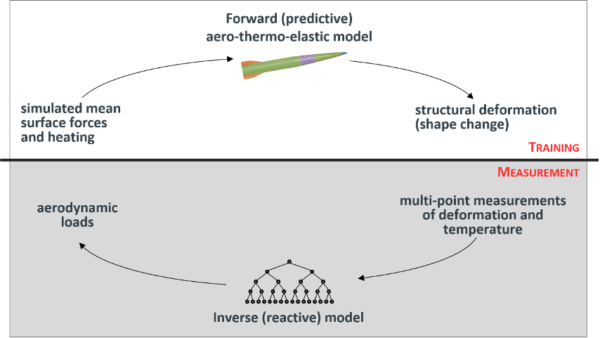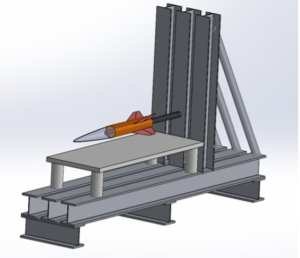In the FAST concept measurements of strain on the internal structure of a vehicle are used to solve an “inverse problem” to determine the aerodynamic loads that caused the deformation. To solve the inverse problem we will use scientific machine learning (SciML) combined with an accurate aerothermoelastic structural model of the vehicle. The SciML algorithm will be trained by imposing notional pressure distributions on the exterior of the simulated vehicle and computing its structural response. Thousands of simulated scenarios of applied forces and the structural response will be used for training. The aerothermoelastic structural response model will be validated using a combination of benchtop and wind tunnel experiments.
- Inferring Aerodynamic Loads from Deformation DataThe FAST measurement technique is enabled by recent advancements in machine learning combined with full-vehicle structural modeling and selected training experiments. Under the FAST methodology, the entire airframe will function as the sensor that, through machine learning and information fusion, yields the desired information. The load estimation algorithms will be rigorously validated using experimental data and the uncertainty of the results will be rigorously quantified. The framework will also provide methodologies for training the machine learning algorithms using simulation data, as well as optimization of the number, type and location of distributed sensors needed.
- Thermoelastic Framework for FAST Training Data GenerationSolving the inverse problem with Scientific Machine Learning requires data to train its algorithms. Our goal is to determine the best way to obtain the required training data for the entire flight envelope in a timely manner and with the appropriate level of fidelity. The training data for this problem will relate the temperature and structural deformation to the aerodynamic loading distribution, the inertial loading, and aeroheating.
- Experimental Validation: Benchtop and Mach 5 WindtunnelThe FAST methodology will be validated by measuring the structural response to known surface loads applied to 3D printed models of a generic hypersonic vehicle. Models will be tested in a no-flow “benchtop” configuration and in the UT Austin Mach 5 Wind Tunnel. Related wind tunnel measurements will be made in UTSA’s Mach 7 Ludwieg… Read more: Experimental Validation: Benchtop and Mach 5 Windtunnel
- Experimental Validation: Mach 7 Ludwieg TubeUT San Antonio, under the direction of Prof. Chris Combs, will conduct experimental validation studies in their newly constructed Mach 7 Ludwieg tube. The Ludwieg tube is an intermittent-flow facility that produces Mach 7 flow for a duration of 50 to 100 milliseconds. Aeroelastic models will be mounted in the test section and simultaneous measurements… Read more: Experimental Validation: Mach 7 Ludwieg Tube







